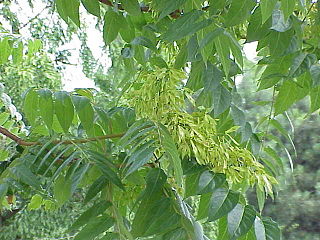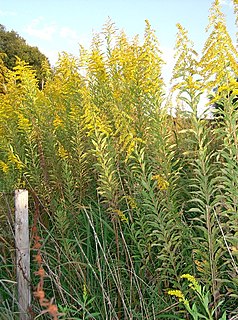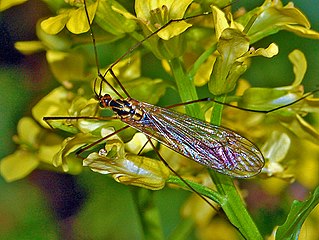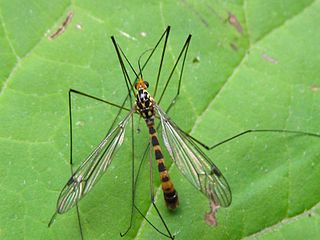
Ailanthus altissima, commonly known as tree of heaven, ailanthus, varnish tree, or in Chinese as chouchun, is a deciduous tree in the family Simaroubaceae. It is native to both northeast and central China, as well as Taiwan. Unlike other members of the genus Ailanthus, it is found in temperate climates rather than the tropics. The tree grows rapidly and is capable of reaching heights of 15 metres (49 ft) in 25 years. While the species rarely live more than 50 years, some specimens exceed 100 years old. Its remarkable suckering ability makes it possible for this tree to clone itself almost indefinitely. It is considered a noxious weed and vigorous invasive species.

The Simaroubaceae are a small, mostly tropical, family in the order Sapindales. In recent decades, it has been subject to much taxonomic debate, with several small families being split off. A molecular phylogeny of the family was published in 2007, greatly clarifying relationships within the family. Together with chemical characteristics such as the occurrence of petroselinic acid in Picrasma in contrast to other members of the family such as Ailanthus this indicates the existence of a subgroup in the family with Picrasma, Holacantha, and Castela.

Vernonia is a genus of about 1000 species of forbs and shrubs in the family Asteraceae. Some species are known as ironweed. Some species are edible and of economic value. They are known for having intense purple flowers. The genus is named for the English botanist William Vernon. There are numerous distinct subgenera and subsections in this genus. This has led some botanists to divide this large genus into several distinct genera. For instance, the Flora of North America only recognizes about 20 species in Vernonia sensu stricto, 17 of which are in North America north of Mexico, with the others being found in South America.

Ageratina altissima, also known as white snakeroot, richweed, or white sanicle, is a poisonous perennial herb in the family Asteraceae, native to eastern and central North America. An older binomial name for this species is Eupatorium rugosum, but the genus Eupatorium has undergone taxonomic revision by botanists, and a number of the species that were once included in it have been moved to other genera.

Solidago altissima, the Canada goldenrod or late goldenrod, is a North American species of goldenrod widespread across much of Canada, the United States, and northern Mexico. It is common in much of its range, and fairly tolerant of landscapes which have been disturbed by humans. It has become naturalized in many parts of the world.

Nephrotoma appendiculata, the spotted crane fly, is a species of crane fly.
Nigricauda, a Latin word meaning black-tailed, may refer to:
Anigre is an African hardwood commonly used for plywood, interior furniture, cabinetry, and high-end millwork applications. It is frequently sliced and sold as veneer, although it is available in board form as well. In board form it is used for boat building, general carpentry, and other light construction uses.

The spotted lanternfly is a planthopper that is indigenous to parts of China, India, Vietnam, and eastern Asia. Although it has two pairs of wings, it jumps more than it flies. Its host plants include grapes, stone fruits, and Malus species, though its preferred host is Ailanthus altissima. In its native habitat it is kept in check by natural predators or pathogens. It was accidentally introduced in Korea in 2006 and has since been considered a pest. In September 2014, it was first recorded in the United States, and it is now an invasive species in eastern Pennsylvania, southwestern New Jersey, northern Delaware as well as northern Virginia.

Nephrotoma flavipalpis is a species of crane flies in the family Tipulidae.

Nephrotoma ferruginea is a species of large crane fly in the family Tipulidae.
Nephrotoma occipitalis is a species of large crane fly in the family Tipulidae.
Nephrotoma virescens is a species of large crane fly in the family Tipulidae.
Nephrotoma cingulata is a species of large crane fly in the family Tipulidae.
Nephrotoma byersi is a species of large crane fly in the family Tipulidae.
Nephrotoma eucera is a species of large crane fly in the family Tipulidae.

Nephrotoma pedunculata is a species of large crane fly in the family Tipulidae.
Nephrotoma tenuis is a species of large crane fly in the family Tipulidae.
Nephrotoma macrocera is a species of large crane fly in the family Tipulidae.

Nephrotoma alterna is a species of large crane fly in the family Tipulidae.










